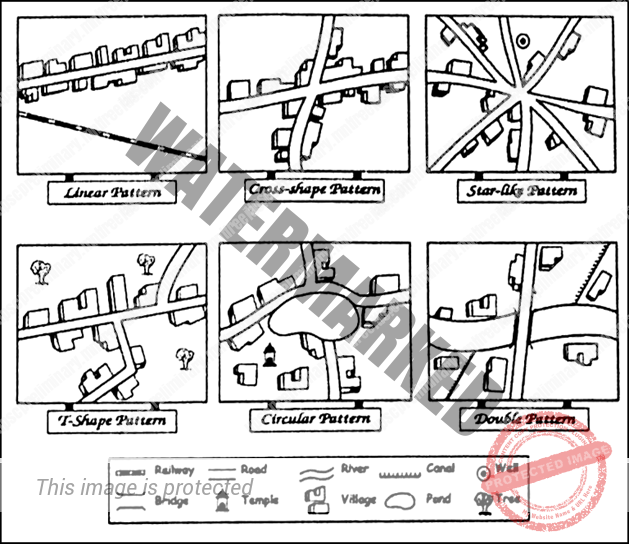- HUMAN SETTLEMENT
- TYPES AND PATTERNS OF RURAL SETTLEMENTS
UNIT 7 – SOCIAL GEOGRAPHY – PART 1
HUMAN SETTLEMENT
In simpler term we can define settlement as any form of human habitation which ranges from a single dwelling to large city.
The word settlement has another connotation as well as this is a process of opening up and settling of a previously uninhabited area by the people. In geography this process is also known as occupancy.
Therefore, we can say settlement is a process of grouping of people and acquiring of some territory to build houses as well as for their economic support.
Settlements can broadly be divided into two types – rural and urban.
- The major difference between rural and urban areas is their function.
- Rural areas have large population engaged in primary activities, whereas urban areas have large population engaged in secondary and tertiary activities.
- Generally, the rural areas have low density of population than urban.
TYPES AND PATTERNS OF RURAL SETTLEMENTS
Type and pattern: Type refers to a category of things having some common features whereas pattern refers to a regular form or order in which a series of things occur. As far as type of rural settlements is concerned, it implies the degree of dispersion of the dwellings.
Types of Rural Settlements
- Compact/clustered/nucleated settlement
- Semi-compact/Semi-clustered/fragmented settlement
- Hamleted settlement
- Dispersed settlement.
- Compact Settlements: Mostly found in fertile regions, these settlements have closely built-up houses. Therefore, in such settlements all the dwellings are concentrated in one central site and this inhabited area is distinct and separated from the farms and pastures.
Maximum settlements of our country come under this category. These settlements are distributed over the entire northern Indo-Ganga plain (from Punjab in the north-west to West Bengal in the east), Orissa coast, basins of Mahanadi in Chhattisgarh, coastal areas of Andhra Pradesh, Cauvery delta of Tamil Nadu, Maidaus of Karnataka, lower Assam, and Tripura, in the valleys of Siwaliks etc.
Sometimes fewer resources also push people to live in compact settlement. In Rajasthan also people live in compact settlement because of the scarce availability of cultivable land and water body. Therefore, they want to make maximum use of available natural resources.
In other cases, people live in compact settlement for security or defence purpose also. The greatest example of this type is in Bundelkhand region of Madhya Pradesh and Uttar Pradesh.
Such settlements generally range from a cluster of about thirty to hundreds of dwellings of different forms, size and functions. On an average their size various from 500 to 2,500 persons in sparsely populated parts of Rajasthan to more than 10,000 persons in Ganga plains.
Very often these settlements have a definite pattern due to closely built area and intervening street patterns. As many as 11 patterns are identified.
Some of them are:
- Linear Pattern: These settlements found along main roads, railways, rivers, etc. on these main streets run parallel to the road. Flood plains, rivers and areas near seacoast generally follow this pattern. E.g.: Ganga flood plains.
- Rectangular Pattern: This is a very common type which develops around the rectangular shape of agricultural fields as it is common to find a system of land measurement based on square units. Village paths and cart tracks also confirm to the rectangular field patterns and run through the village in north-south and east-west directions. Accessibility to farms and fields and connectivity to other settlements lead to rectangular shape of settlements. The settlements of coastal Maharashtra and Andhra Pradesh and either side of Aravalli hills, etc. May be cited for examples.
- Cross Shaped Pattern: In the areas where two routes cross each other at right angles. Here settlements are built in all four directions.
- Circular Pattern: These settlements are characterized by
a very high degree of compactness. The outer walls of dwellings adjoin each other and present a continuous front so that when viewed from outside, the villages look like a walled and fortified enclosure pierced by a few openings. The round form was a natural outcome of maximum aggregation for the purpose of defence during the past.
(v) Radial Pattern: In this type, a number of streets converge on one centre which may be a source of water, a temple or mosque, a centre of commercial activity or simply an open space.
Thus, the streets seem to be radiating from a common centre. Examples are settlements near Guru shikar, Mount Abu in Rajasthan

